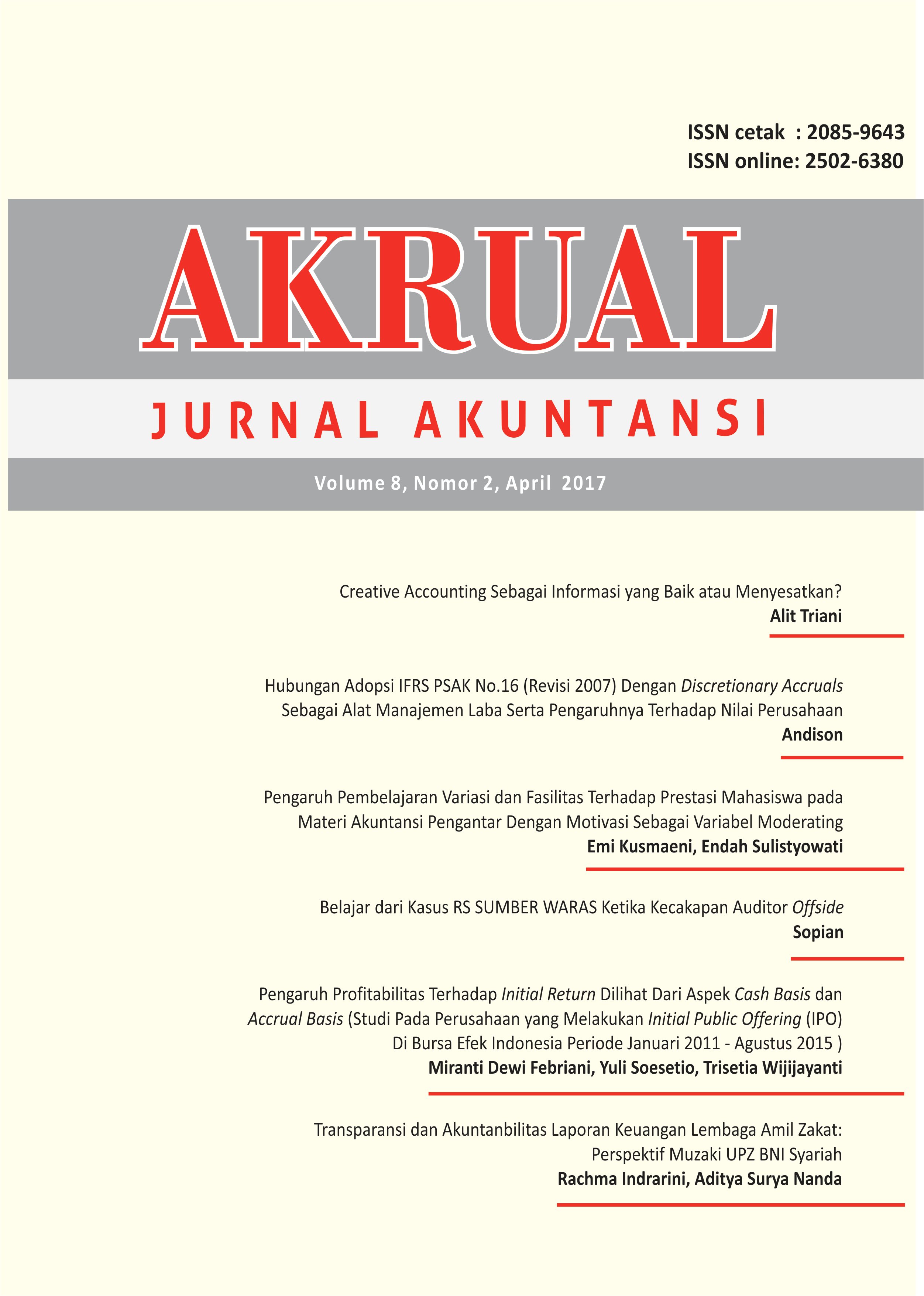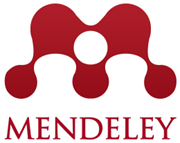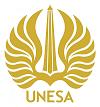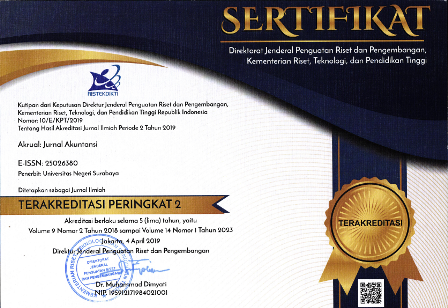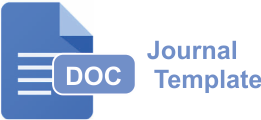Creative Accounting Sebagai Informasi Yang Baik Atau Menyesatkan?
DOI:
https://doi.org/10.26740/jaj.v8n2.p1-9Keywords:
asimetri informasi, laporan tahunan, tata kelola perusahaanAbstract
Abstrak
Tujuan penelitian ini untuk melihat creative accounting sebagai informasi yang baik atau menyesatkan bagi investor. Metode penelitian yang digunakan kualitatif dengan pendekatan deskriptif. Teknik analisis yang digunakan dalam penelitian ini dengan pendekatan studi pustaka. Hasil penelitian ini menunjukkan creative accounting yang dilakukan oleh manajemen untuk menaikkan nilai perusahaan dan memberikan kepuasaan pada investor. Fenomena creative accounting lebih banyak terjadi di antara periode 2002 sampai 2008. Upaya creative accounting meskipun dapat dibenarkan dalam tataran teori, namun tidak dapat diterima dari sisi etika. Pelaporan kegiatan perusahaan dengan upaya creative accounting secara norma salah, dikarenakan hal ini memberikan informasi yang menyesatkan bagi pengguna informasi tersebut, seperti calon investor. Secara empiris, sejak diberlakukannya IFRS (International Financial Reporting Standards) , berita media tentang creative accounting pada perusahaan-perusahaan besar di beberapa negara mulai berkurang. Namun, dalam meta analisis studi dari Dechow (2011), menemukan cara baru untuk mendeteksi upaya creative accounting dengan model reverse.
References
Balaciu, D. E., Bogdan, V., Feleag, L., & Adela-Laura, P. (2014). œ Colorful Approach Regarding Creative Accounting . An Introspective Study Based On The Association Technique. Accounting And Management Information Systems, 13(4), 643664.
Belkaui, A, R. (2006). Accounting Theory. Buku Satu. Edisi 5. Jakarta: Salemba Empat
Dechow, P. M., Hutton, A. P., Kim, J. H., & Sloan, R. G. (2011). Detecting Earnings Management¯: A New Approach *. In Workshop Journal Of Accounting Research Conference (Pp. 169). DOI: https://doi.org/10.2139/ssrn.1735168
Dechow, P. M., Sloan, R. G., & Sweeney, A. P. (1995). Detection Earnings Management. The Accounting Review, 70(2), 193225.
Gherai, D, S., & Balaciu, D, E. (2011). From Creative Accounting Practices And Enron Phenomenon To The Current Financial Crisis. Annales Universitatis Apulensis Series Oeconomica, 13(1), 3441.
Jones, J, J. (1991). Earnings Management During Import Relief Investigations. Journal Of Accounting Research, 29(2), 193228. DOI: https://doi.org/10.2307/2491047
Kellog, I., & Kellog L,B. (1991). Fraud, Window Dressing And Negligence In Financial Statements. New York: Mcgraw-Hill. Terdapat pada: nla.gov.au
Mamo, J., & Aliaj, A. (2014). Accounting Manipulation And Its Effects In The Financial Statements Of Albanian Entities. Interdisiplinary Journal Of Research And Development, 1(2), 5560.
Rajput, M,S. (2014). Creative Accounting: Some Aspects Dr. Mahesh Singh Rajput. International Journal Of Businness And Administration Research Review, 2(4),
Schiper, K. (2003). Principle-Based Accounting Standard. Accounting Horizon, 17(1), 61-72. DOI: https://doi.org/10.2308/acch. 2003.17.1.61
Sukanya, P. (2005). Creative Accounting In Small Advancing Countries-The Greek Case. The Accounting World. May-June.Pp.70-72.
Triyuwono, I, D., Mulawarman, A., Prawironegoro, A., & Darsono. (2016). Filsafat Ilmu Akuntansi: Berpikir Ontenplatif, Holistik, Intuitif, Imajinatif, Kreatif, Rasional Dan Radikal Dalam Akuntansi. Jakarta: Mitra Wacana Media.
Vyas, A. H., Ambadkar, R., & Bhargava, J. (2015). True And Fair View- A Fact Or Illusion In The World Of Creative Accounting. International Journal Of Multiisplinary And Current Research, 3(June), 572575.
Wokukwu, K. (2015). Creative Accounting¯: Unethical Accounting And Financial Practices Designed To Boot Earnings And To Meet Financial Market Expectations Stillman College. Journal Of Business & Economic Policy, 2(1), 3948.
Downloads
Published
How to Cite
Issue
Section
 Abstract views: 7049
,
Abstract views: 7049
, PDF Downloads: 3558
PDF Downloads: 3558

